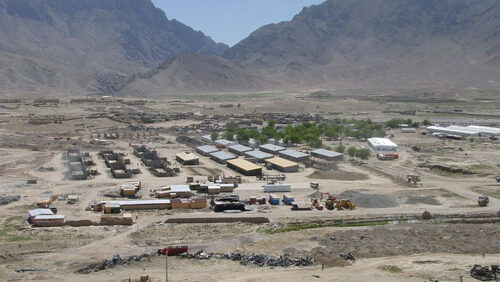A UN Security Council report has found that since the Taliban resumed ruling Afghanistan in 2021, the country has returned to being a shelter for terrorist organizations, increasing the chances of conflict on the Afghanistan-Iran border
The al-Qaida terrorist organization is having a resurgence in Afghanistan under the ruling Taliban, setting up eight new training camps alongside five madrasas, Islamic educational institutions, around the country, a report from the UN Security Council in late January has revealed.
The report said that the training camps are located in various provinces, including Ghazni, Laghman, Parwan, and Uruzgan. It also listed sites used by al-Qaida to move its operatives in and out of neighboring Iran, and said that a new base to stockpile weaponry has been established in the Panjshir Valley, north of the capital, Kabul.
“The group maintains safe houses to facilitate the movement between Afghanistan and the Islamic Republic of Iran in the provinces of Herat, Farah, and Helmand, with additional safe house locations in Kabul,” the report said.
This accommodation of al-Qaida within Afghanistan has validated longstanding fears voiced by many observers regarding the country once again becoming a safe haven for terrorist organizations under Taliban rule
“This accommodation of al-Qaida within Afghanistan has validated longstanding fears voiced by many observers regarding the country once again becoming a safe haven for terrorist organizations under Taliban rule,” Shahin Modarres, an international security analyst specializing in Iran affiliated with the Center for Middle East and Global Order think tank, told The Media Line.
Modarres said that al-Qaida and the Taliban, which retook rule over Afghanistan in 2021 as US-led coalition forces left the country, have a shared history of collaboration and ideological alignment. He said that throughout their insurgency against the coalition forces, both organizations maintained deep-seated ties rooted in a common jihadist worldview and mutual support for each other’s objectives.
Silvia Boltuc, managing director at the SpecialEurasia business and geopolitical intelligence platform, told The Media Line that the political instability sparked in Afghanistan since the return of the Taliban has provided a conducive setting for the resurgence of terrorist operations.
“There has been a notable escalation in terrorist attacks, from roadside and suicide bombs to rocket and mortar fire, direct fire, kidnappings, and violent crimes,” Boltuc said, adding that many incidents targeting religious sites occurred during religious festivals.
She said that Islamic State Khorasan Province, a regional branch of the extremist Islamic State group, has been involved in ongoing hostilities, targeting ethnic minorities and government establishments. In addition, other extremist groups such as Tehreek-e-Taliban Pakistan and its breakaway faction Jamaat-ul-Ahrar have been active in the country.
The report also said that suicide bomber training camps for Tehreek-e-Taliban Pakistan have been set up in Kunar Province.
“The relationship between the Taliban and al-Qaida remains close, and the latter maintains a holding pattern in Afghanistan under Taliban patronage,” the report said.
Modarres said that apart from the historic ties and ideological similarities between the two groups, al-Qaida’s presence provides the Taliban with strategic advantages, including access to experienced fighters, operational expertise, and potential leverage in regional dynamics.
The border between Afghanistan and Iran has been tense for several years, with the two Islamist governments, one Sunni and the other Shiite, citing various grievances against each other, each claiming that the other is persecuting and failing to protect their ethnic minorities. The tensions are compounded by a longstanding dispute over the Helmand River.
Boltuc said that in the early 2000s, a slight migration of al-Qaida leaders towards Iran took place and Iran arrested many of them, holding them for use in any prisoner exchanges in the case of conflict with Afghanistan.
She said that Iran possesses vast rural regions that are challenging to govern.
“If this is seen as an advantage for al-Qaida fighters seeking concealment, the significant influx of undocumented Afghan migrants entering Iran annually provides an ideal opportunity to enter the country undetected,” she said.
Modarres said that al-Qaida’s potential interest in establishing bases in Iran reflects a strategic calculus aimed at enhancing its operational capabilities and expanding its reach beyond Afghanistan.
“Iran’s geographic proximity to Afghanistan, coupled with its complex geopolitical dynamics, presents al-Qaida with opportunities to establish logistical hubs, recruit new members, and coordinate activities across borders,” he said.
Possessing bases in Iran could serve multiple purposes for al-Qaida. He said that these include facilitating the movement of operatives, accessing resources and support networks, and establishing a presence in a region with significant strategic value.
The presence of al-Qaida bases in Iran could potentially escalate tensions along the Afghan-Iranian border and exacerbate existing regional dynamics
However, increased al-Qaida activity along the border might bring local and regional ramifications.
“The presence of al-Qaida bases in Iran could potentially escalate tensions along the Afghan-Iranian border and exacerbate existing regional dynamics,” Modarres said.
He said that concerns regarding cross-border terrorism, infiltration by militants, and security risks could lead both Afghanistan and Iran to bolster militarization and surveillance along their mutual border. This escalation could exacerbate tensions and potentially result in incidents. This could also lead to further diplomatic complications between the two countries.
“Afghanistan and Iran may perceive each other as threats or adversaries, leading to a cycle of suspicion, hostility, and potentially actions that can lead to escalation,” Modarres said.
Additionally, he said that increased tensions along the Afghan-Iranian border might disrupt trade, worsen ethnic and sectarian rifts, and escalate local conflicts.
“The convergence of al-Qaida and Iran’s interests may embolden other terrorist groups and state sponsors of terrorism, leading to increased radicalization, recruitment, and violence in the region,” he said.


















































